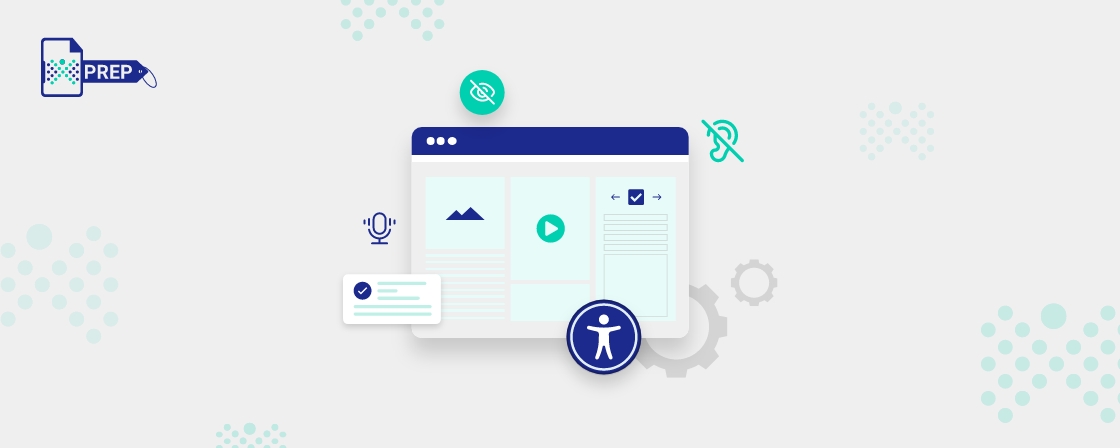How AI is Changing Web Accessibility
COVID-19 forced everyone to deal with social distancing and lockdowns. While technology eased this strain for many, it wasn’t the same for people with disabilities. According to The World Bank, 15% of the population lives with a disability. Still, much work remains to be done to close today’s digital divide. And developers are looking to artificial intelligence to bridge the gap.
Artificial Intelligence (AI) is a simulation developed for intelligent devices and systems that enable machines to perform problem-solving and regular tasks. AI has contributed significantly to communication, accessibility, and independent living for people with disabilities. They can now access services to use every day through the digital world with ease, for instance:
- Objective Ed’s Braille AI Tutor helps children learn through speech recognition with the help of a braille display.
- DeepMind by Google can identify specific lip movements for particular words with an accuracy rate of 46.8%, allowing it to convert speech to text in real time.
- AI-powered image recognition Google Vision API helps users identify images and determine if an image is labeled safe. This technology is still developing, but there are high hopes for its future application.
How AI could help
To narrow the web accessibility gap, we need to incorporate more scalable AI solutions for people with disabilities, like:
- Self-driving vehicles
Self-driving cars offer new freedom for the mobility issues faced by disabled users. Using sensors and cameras with AI algorithms, it could collect necessary data about the surrounding environment to reach the chosen destination. If fully integrated into society, it could make travel more accessible. - Sign language
Sign language is an AAA high-level requirement of WCAG, which is challenging for websites and multimedia. An AI-based program could translate and transcribe automatically, benefiting the deaf and hard of hearing. - Alternate text
The lack of alt text for images is still one of the most common accessibility issues. AI can help take this forward and automatically give information without manually entering it. - Make information easier to understand
The Google Brain team published a model for TensorFlow, an open-source machine learning framework that can generate single-line summarizations of news articles. This could benefit people with cognitive impairments and learning disabilities by making content easy to digest. - Make websites accessible
Only 2% of the 350 million active websites have accessibility compliance. AI-powered solutions like website remediation can help with website accessibility without altering their source code to improve how people with disabilities use and interact with websites. AI might even automatically create accessible web pages in the future.
What has AI achieved in accessibility
AI technology introduces disabled people to opportunities for accessibility and inclusion. Let’s see how AI has improved the lives of those with disabilities.
- Communication Technologies
Communication Technologies such as Alexa, Echo, Siri, and more, assist people with disabilities in navigating everyday life on their computers and phones using their voices. Users can easily set up an alarm, do a Google search, manage their schedule, etc. AI’s communication progressions are broader than that. AI is improving cognitive systems to help describe images to people with visual impairments. Its speech-to-text and text-to-speech technologies, already used by 40 million people in the U.S., make it easier for speech-impaired users to communicate with others. - Autonomous Transportation
Many navigation apps based on AI technology can help people with disabilities gain more autonomy. Popular apps like Google Maps, Moovit, and Wheelmap can prepare users for their day out by providing information about traffic and the premises, including the location of ramps and elevators, entrances, parking spots, restrooms, and seating arrangements.
AI-powered self-driving technologies developed by Google’s Waymo, Uber, Drive.AI, and others are also increasing mobility for people who’d otherwise be bound to their homes. - Independent AI technology
Independent AI technology has enhanced accessibility at home for people with disabilities by supporting independent living. With smart speakers and virtual assistants like Amazon Echo with Alexa, Google Home with Google Assistant, and Apple’s Home Pod, people with disabilities can control everything by voice. Along with smart home devices like lighting, curtains, and thermostats, it can make daily activities easier for people with disabilities. - Accessibility Inclusivity
It means that everybody can access any service regardless of their profiles and disabilities. Microsoft Accessibility Checker or Adobe Accessibility Checker ensures people with disabilities can still access information by making documents accessible.
Conclusion:
Disabled people are 20 percent less likely to own smart devices since most content is still not accessible. Hence, AI-powered solutions could make a real difference for them. Continual Engine is committed to creating accessible content and delivering transformative learning solutions through AI in simple, inexpensive, and effective ways. Our sophisticated AI-enabled accessibility technology and solutions are transforming the process of accessibility, reducing cost by up to 50% and cycle time by 50-70%. Continual Engine’s AI-enabled alt-text writing services for STEM-related complex images and AI-Enabled PDF remediation services offer quick turnarounds, improved results, and compliance with Section 508, WCAG 2.1, PDF U/A or ADA at affordable prices that make it easy to integrate AI and accessibility into your digital environment.

